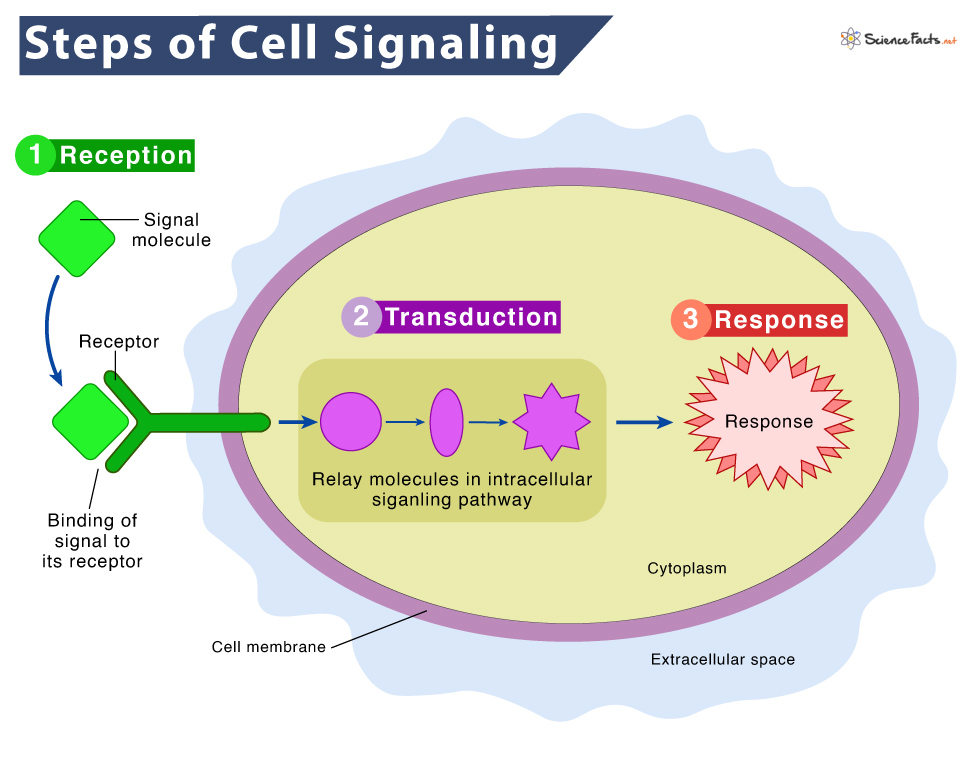Cell Signaling
Cells in eukaryotes need to communicate in a coordinated way to function correctly. For that purpose, cells must receive and process signals coming from their neighbors, integrate the information they receive, and transfer them to their targets for necessary action. Sometimes cells can also signal through direct contact. In contrast, single-celled prokaryotes use sensors in their body for signaling and for navigating to their food source.
Thus, cell signaling and communication describe the ability of cells to respond to stimuli from their environment producing cellular responses. Some common examples of cell signaling are healing wounds after injury, forming immune responses during the invasion by pathogens, and altering gene expression.
What is the Nature of Cell Signaling
Most signals are chemical. In eukaryotes, hormones, growth factors, neurotransmitters, and extracellular matrix components are the common types of chemical signals used for communication. They can affect locally within a short region as found in neurotransmitters, traveling between adjacent neurons. Signals can also act over a vast region, as in follicle-stimulating hormone (FSH), which travels from the brain to the ovary.
Sometimes, the cell also responds to mechanical stimuli found in the sensory skin cells that respond to touch or electrical stimuli that use intercellular channels, connecting adjacent cells (gap junctions) to pass signals.
How Do Cells Recognize Signals
All cell signaling pathways can be broadly divided into three stages or steps.
Step 1: Detection and Binding of the Signal to its Receptor
As proteins or other molecules, signals are secreted from a cell and are released into the extracellular space. In order to receive the signal, the other cell must have the proper receptor that can bind to the signal. The cell that receives the signal is called the target cell. Signaling molecules that bind specifically to other molecules are named ligands.
Receptors are transmembrane proteins that bind to signaling molecules outside the cell, such as protein-coupled receptors and receptor tyrosine. Some receptors also exist inside the cell or even in the nucleus. They typically bind to molecules passing through the plasma membrane, such as gases like nitrous oxide and steroid hormones like estrogen.
Step 2: Signal Transduction
Once the ligand is bound to its compatible receptor, the shape or activity of the receptor alters, triggering change inside the cell. Finally, it causes an alteration in gene expression, causing a series of biochemical reactions within the cell. . Signal transduction is usually a pathway of several steps.
These signaling pathways inside the cell, also called signal transduction cascades, amplify the message, producing multiple intracellular signals. Each relay molecule changes the following molecule in the pathway somehow or the other.
Step 3: Target-Cell Response
Finally, the signal triggers a specific cellular response.
How Do Cells Respond to Signals
At a particular time, a cell receives and responds to numerous signals. Many signal transduction pathways are operating in its cytoplasm. There are many points of intersection among these pathways. Through this network of signaling pathways, the cell constantly integrates all the information it receives from its external environment.
Types of Cell Signaling
There are four primary forms of cell signaling based on the distance the signal travels to reach its target.
1. Paracrine Signaling
It occurs in cells that are close to each other and thus act locally within a short region. Here, the signaling molecule diffuses to its neighbor through the extracellular matrix to reach its target. Paracrine signals usually elicit quick responses that last for a short period. An example of paracrine signaling is the transmission of impulses across synapses in nerve cells or the release of chemokines by neutrophils.
2. Endocrine Signaling
It works in cells that transmit signals (usually hormones) over long distances. Endocrine signaling is produced by specialized cells that release their signals into the bloodstream, carrying them to target cells present in the distant parts of the body. The endocrine glands in humans such as the hypothalamus, pituitary, pancreas, thyroid, and gonads produce hormones and function by endocrine signaling.
3. Autocrine Signaling
It is a form of cell signaling where the cell signals to itself, releasing a ligand that binds to its receptor. Autocrine signaling often occurs during the early developmental stage of an organism to ensure that cells develop into correct tissues and assume correct functions. It also regulates pain sensation, inflammatory responses, and programmed cell death in the infected or cancerous cell.
4. Signaling through Cell-Cell Contact
Plasmodesmata in plants and gap junctions in animals are tiny channels connecting neighboring cells directly. These intercellular channels allow small signaling molecules, called intracellular mediators, to diffuse between the two cells. Such channels allow small molecules and ions to move between cells but prevent large molecules like proteins and DNA from passing without assistance. It allows a group of cells to coordinate their response to a signal received by a single cell.
A different form of cell-cell signaling involves two cells binding to one another, carrying complementary proteins on their surfaces. The interaction changes the shape of one or both proteins, transmitting a signal. This type of cell signaling is found in immune cells using cell-surface markers to identify self cells and cells infected by pathogens.
Why is Cell Signaling Important
In multicellular organisms like humans, cell-cell signaling allows cells to coordinate their activities, ensuring that tissues, organs, and organ systems function correctly. In contrast, unicellular organisms such as bacteria and yeast use cell signaling to communicate, a process known as quorum sensing.
-
References
Article was last reviewed on Friday, February 17, 2023




